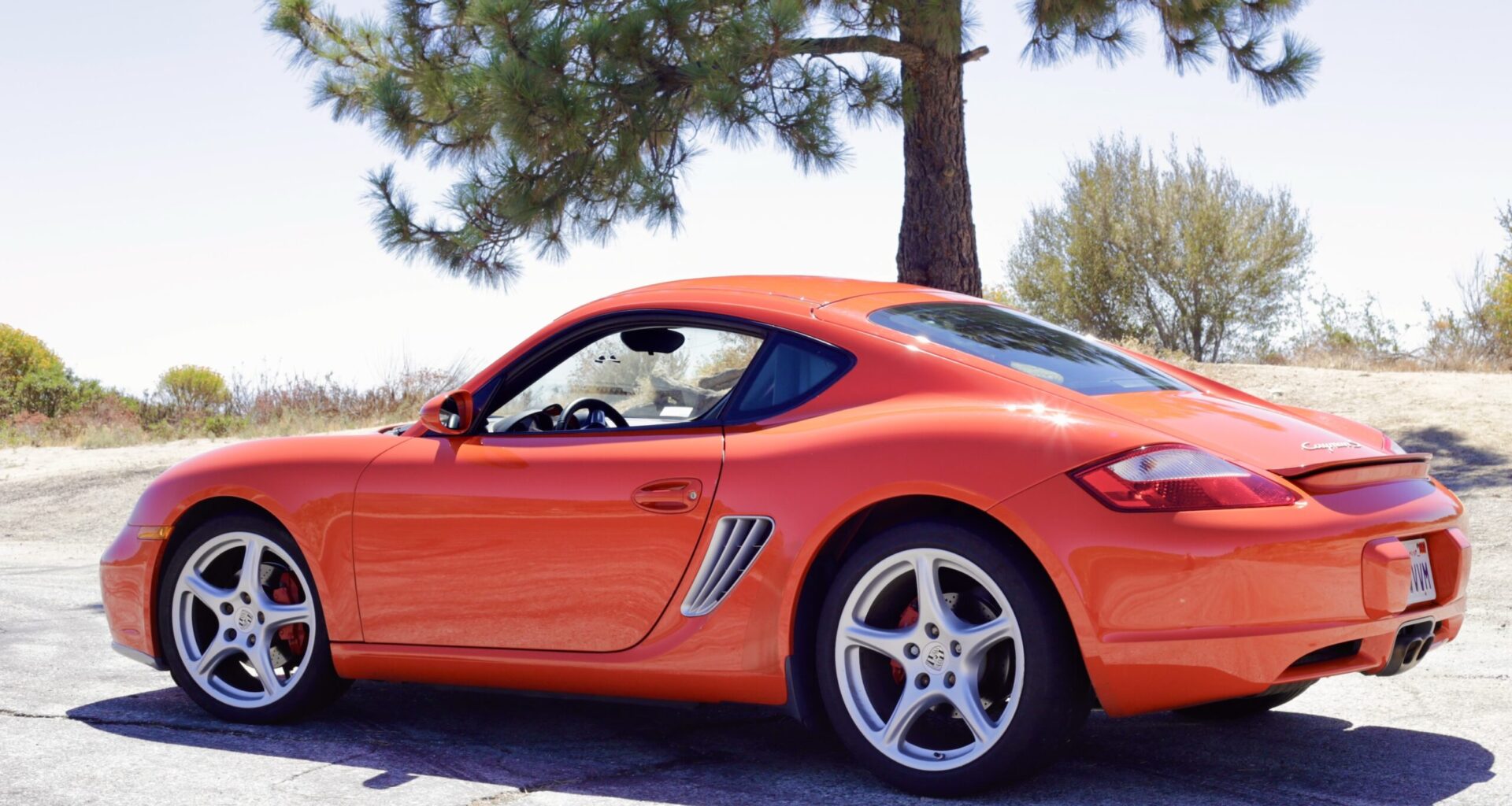When a new enthusiast car comes out, the usual course of action is that the coupe comes first, and the convertible comes later. Take the venerable BMW 3-Series, for example, or several versions of the Corvette, which is as common to find in open-top form as it is with a fixed roof. It’s rarer for the opposite to happen, for vehicles that start out as convertibles to later be offered as coupes. That’s just what happened with the Boxster/Cayman cousins, though. When the debut 986-generation Porsche Boxster hit the market in 1997, it became an instant success and went for its whole production run in drop-top-only form. Then, the follow-up 987 followed in 2005, and just a year later, Porsche introduced a 987-based model sporting the Boxster’s chassis but with a solid roof—the Cayman.
The Cayman has since lasted three separate generations with a smattering of updates in between. All three are beloved among enthusiasts, but the original 987—in its 987.1 and revised 987.2 forms—offers immense European mid-engine sports car value for the money, with excellent-condition examples for most trims coming in at under 40 or 50 grand. Let’s dig into the basics of the 987 Cayman, what it’s like behind the wheel, what it’s worth, and what to know if you’re considering picking one up.
 Peter Nelson
Peter Nelson
The Basics
Initially teased in spring 2005 and followed by its official unveiling at the Frankfurt Motor Show that fall, the 2006 Porsche Cayman was an instant hit. Debuting as the S variant, AutoWeek awarded it Best in Show. Why? “Because it’s sexy as hell, that’s why—and looks far better in the sheetmetal than it does in photos, which don’t even begin to capture its aggressive stance, strong rear shoulders and arching roofline,” the editorial team wrote. They continued that it was more than a Boxster, a little less than a 911, with 911-like torsional rigidity, balance that bests the 911 due to its mid-engine layout, and all for just below $60,000.
Looks and chassis are just two pieces of the puzzle, though. Sporting a 3.4-liter version of the M97 engine, the 2006 987.1 Cayman S’s rated output was 295 horsepower and 250 pound-feet of torque. This enabled the sub-2900-pound coupe to hit 60 mph in just 5.1 seconds when equipped with the standard six-speed manual transmission. Opting for the five-speed conventional Tiptronic box increased the run by almost a full second.
For the 2007 model year, Porsche introduced a lower-output model commonly referred to as the “Base” Cayman among enthusiasts. While the M97 engine’s exterior dimensions are the same, its displacement shrank to 2.7 liters, with a five-speed manual gearbox as standard and a six-speed manual as a rare optional upgrade. It produced 240 hp and 201 lb-ft of torque, which was good enough for a 5.8-second 0-60 run. Again, this increased nearly a second when paired with the same five-speed Tiptronic.
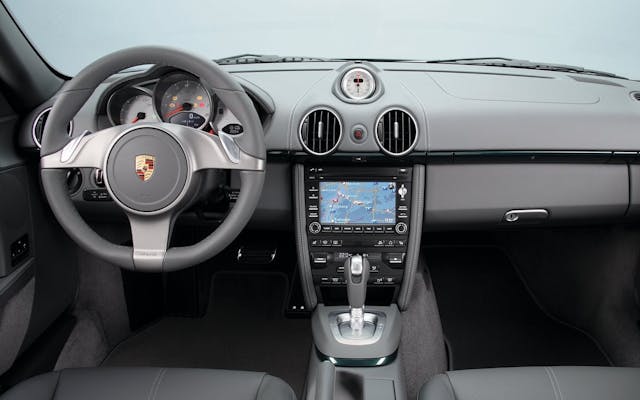 Porsche
Porsche
The Cayman’s recipe for success continued with hydraulic power steering, MacPherson suspension at all four corners, a low-slung driving position, a small footprint, and one-of-a-kind looks that pay homage to Porsches of yore, like the 550. With just the right amount of aggression sketched into its pronounced rear haunches, front fenders, and wide track, it’s truly one of ex-Porsche designer Pinky Lai’s greatest creations.
A revision dubbed 987.2 debuted in 2009 and lasted until the generation’s end in 2012. The most obvious changes were the updated headlights and taillights, as well as a nicer steering wheel and upgraded switchgear. Under the skin, the Tiptronic was dropped in favor of Porsche’s PDK (Porsche Doppelkupplungsgetriebe, or dual-clutch gearbox), and there was a new-generation Porsche engine, too. Known as the MA1, the biggest improvements over the M97 were direct injection and no more intermediate shaft or its infamous bearing—but more on the latter, later.
Power jumped up substantially to 320 hp and 273 lb-ft in the S model, while the Base’s displacement increased to 2.9 liters and output to 265 hp and 210 lb-ft. The sole manual gearbox was a six-speed stick, and the PDK had seven gears split between its two clutches. A higher-tier, limited Cayman R was available for the 2012 model year that got a 10-hp bump plus myriad chassis tweaks to make it more track-focused. Getting to 60 mph took just under five seconds in the 987.2 S, whereas the Base hit the mark about half a second later. Substitute the blazingly fast PDK for three pedals, and each figure decreased very slightly.
 Peter Nelson
Peter Nelson
Driving a Cayman Today
I recently had the opportunity to refresh my impressions of the 987 by taking a friend’s low-mileage and basically stock 2006 Cayman S for a spin.
First things first: It’s a blessedly small two-seater. The current (not for long) 982-gen 718 Cayman is considered small by modern standards, but the 987 is smaller still, and truly feels like a toy to toss around. Yet it also feels confident enough to carve responsibly through a twisty mountain road, which can’t be said for a lot of modern enthusiast chassis. In fact, the only new showroom fare that offers this chuckable sensation for reasonable money are the Mazda MX-5 and Toyobaru twins.
Despite the original Cayman’s size, its interior dimensions are surprisingly roomy. I’m 6-foot-3 and don’t have any issue fitting in or seeing out. There’s even enough headroom if I were to don a helmet. The seat pushes back enough to comfortably accommodate long legs, though the steering wheel barely telescopes out from the dashboard. And there’s ample storage throughout—while the cupholders are quintessential Porsche (meaning, not that great), there are many cleverly placed cubbies, and there’s a respectable amount of cargo room in both the trunk and frunk.
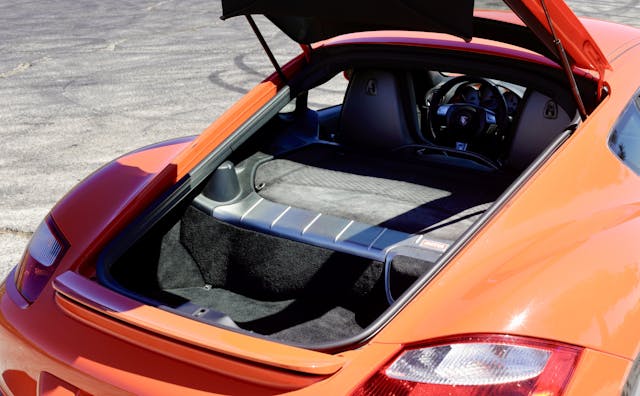 Peter Nelson
Peter Nelson
 Peter Nelson
Peter Nelson
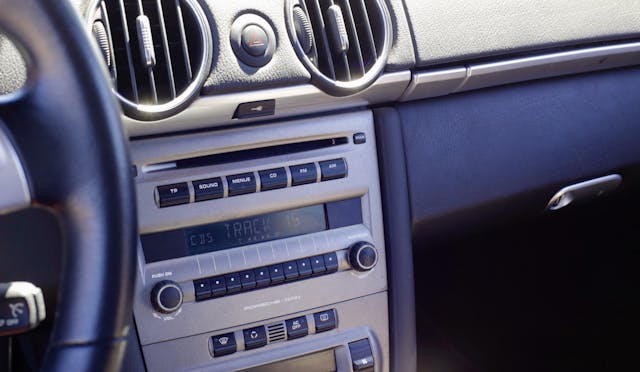 Peter Nelson
Peter Nelson
The debut-generation Cayman has so much sense of occasion. If this one were mine, I’d always be looking for excuses to drive it. Sliding in, pushing in the clutch, and twisting the key unleashes a beautiful flat-six song playing quintessential Porsche notes. The spirited M97 gains and loses revs quickly, and figuring out the right mix of gas and clutch while smoothly slotting its cable-operated shifter into each gear is a cinch. This example has just under 52,000 miles on the clock and has been very well taken care of, with no concerning clunks, just a solidly comfortable ride quality that soaks up craggy Los Angeles streets with ease.
It’s easy to have a skewed interpretation of power-to-weight in our modern era of dual-clutch gearboxes, mammoth turbo-sourced torque, and hybrid assistance. But 295 hp in the 987.1 S feels just right. Thanks in part to Porsche’s VarioCam Plus variable valve timing, as well as a variable-length double-chamber intake manifold, the 3.4-liter M97 offers loads of low-end grunt, yet also screams at its 7200 RPM redline. Even after 52,000 miles and nearly 20 years, that original 0-60 of five-ish seconds feels very doable.
My tester’s brakes are firm and easy to modulate, but I suspect that my friend upgraded the fluid and chose a more performance-oriented pad. The cable-operated shifter feels characteristic of the era with reasonably short throws, OK spring, and positive enough engagement in each gear. Enthusiasts say that a prime upgrade here are 911 GT3 cables and the sturdier components associated with their movement. When it comes to pedal placement, it’s generally good in the 987, but I had to readjust my footing quite a bit to execute smooth heel-toe downshifts.
 Peter Nelson
Peter Nelson
The 987 comfortably cruises at high speed on the highway, with surprisingly muted road noise considering the Cayman S’s light weight and low proximity to the ground. What isn’t such a surprise is that this car is immense fun on a good road. This example has an early form of Porsche Active Suspension Management (PASM), the automaker’s version of adaptive damping, and it works well considering its age. Through a variety of different corners, undulations, and elevation changes, the chassis exudes confidence and grip, and keeps roll at bay. Communication is top-notch, particularly through the steering rack, which is always a treat when there’s very little weight over the front end. I was impressed by the lack of squeaks and rattles while hitting mid-corner bumps, too, which is a different story in my own slightly newer BMW 128i.
Everything I’ve touched on so far points to a solid daily runabout or weekender with a unique and engaging driving experience. It’s also a bit of a rare bird, as there are few mid-engine sports cars out there with torquey naturally aspirated engines and hydraulic power steering, as well as good-quality interior materials, solid cargo space, and stylish looks to boot.
What to Pay
Unlike some lower-tier Porsche models of the past, 987 Caymans never really depreciated to the point of being truly “cheap,” but they remain a temptingly good value considering their exotic layout and the premium badge on the nose. Generally, their prices have kept relatively steady over the past decade, with a bump during the early 2020s.
Current condition #2 (excellent) values in the Hagerty Price Guide range from $35,400 for a “Base” car to $42,700 for an early 2007-08 S, $48,800 for a 2009-12 S. The Cayman R occupies a completely different market segment at $90,300. Caymans with a little more use in #3 (good) condition can be had for $29,900 in base form, and $35,000-$45,000 in S form. Expect a 25% discount for Tiptronic-equipped models, and a 10% one for PDK-equipped cars. Compared to six years ago, before the pandemic boom, values are up 32% for the base model and 18% for the S.
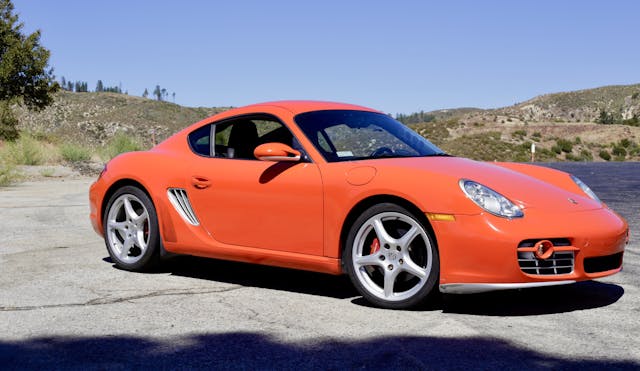 Peter Nelson
Peter Nelson
Reliability Concerns/What to Look For
A top concern for enthusiasts, particularly those considering a 987.1 or 987.2 Cayman as their first Porsche, is reliability. Thankfully, the M97 mostly resolved some of the issues that the M96 (2005-08) was known for regarding its IMS bearing design. However, some issues persisted.
I spoke to Charles Navarro, Founder and President of LN Engineering, for more insight about what to be aware of with the 987 Cayman, as well as to get a good idea of servicing and any potential reliability improvements.
For the most trouble-free experience, the newer and least powerful, the better. “My number-one recommendation is the base 987.2 [987 on] Cayman,” Navarro says. “There’s no IMS bearing to ever worry about, the PDK is worlds better than the conventional Tiptronic [if you’re after an automatic], and the power-to-weight is noticeably better than the base 987.1.” He also notes that the price difference between the two generations of Base is sometimes only a couple grand on the used market, so it’s worth being picky. Otherwise, if a 987.1 is in the cards, particularly a well-taken-care-of example with good service history, the original is still pretty sturdy.
Some M96 and M97 engines can suffer from what’s known as bore score, in which the cylinder walls incur deep scrapes that eventually kill compression, cause heavy oil consumption, and other bank account-draining issues. However, a strong case for the 987.1 Base’s 2.7-liter engine is that it doesn’t suffer this fate. Navarro shares that it utilizes cast, smaller pistons with better tolerances as opposed to the 3.4’s forged units with less-ideal tolerances and coatings that aren’t as sturdy. Additionally, the 2.7 has the same amount of cooling as the 3.4, but its lower power figures mean less overall stress for the M97’s internals.
Then, we can’t forget about the dreaded IMS bearing, most infamously found in Porsche’s M96 engine. When these fail, it throws off cam timing and causes catastrophic damage. The good news is IMS failure in the M97 is far rarer than in the M96 due to the bearing’s larger size and better design. But for added security, “a good rule of thumb is to remove the bearing’s cover if you’re in there doing a clutch job, that way the bearing is fully immersed in oil,” Navarro says.
 Peter Nelson
Peter Nelson
 Peter Nelson
Peter Nelson
Peace of mind is worth paying for with any Porsche, and during our conversation, Navarro repeatedly stressed the importance of a pre-purchase inspection (PPI) from a reputable Porsche shop. They’ll be able to borescope the cylinders, scan the ECU for an over-rev count, perform measurements that indicate the health of the AOS (air-oil separator) system, and inspect other Porsche-specific concerns. But it’s important to point out that not all 3.4-equipped 987.1s suffer from bore score, particularly if they’ve been meticulously maintained and treated right. Given 5000-mile-or-less full-synthetic oil intervals, regularly driving the car (including revving it out when it’s up to operating temperature), and not letting it sit at idle for long periods of time will do wonders for a 987 Cayman.
Some other areas to keep an eye on are the water and power steering pumps. “Replacing the water pump with a genuine or OE-matching quality water pump [at least] every four years is a must,” Navarro shares. The impeller may be plastic, but the bearing on the shaft is of good quality. The problem with aftermarket versions with metal impellers is that they utilize a poor bearing design to save cost.
Power steering pumps are worth discussing due to their plastic reservoirs. The easiest way to avoid hot fluid boiling over from, leaking from, or even melting the reservoir is to install a cooler. Driving technique comes into play here, though. Navarro says that failure here is often due to sawing at the wheel on track; a practice commonly known to 911 drivers. A conventional performance steering technique—meaning, nice n’ smooth—greatly reduces the chance of this happening.
These are the larger concerns, but owners on forums report that there are still more to keep an eye out for. Replacing the AOS, interior material aging, foam blowing through the interior vents due to aging HVAC systems, oil and coolant leaks, are worth checking. A proper PPI will note the status of all of these.
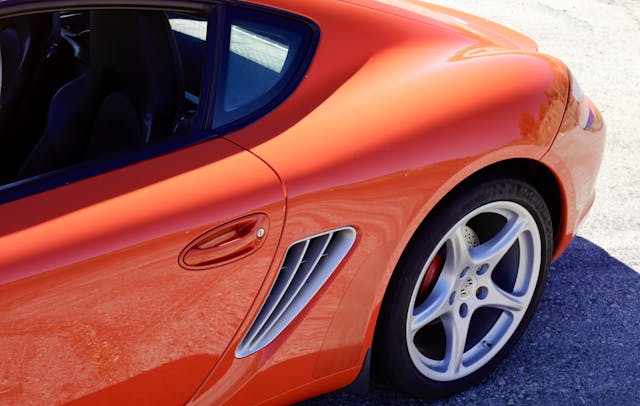 Peter Nelson
Peter Nelson
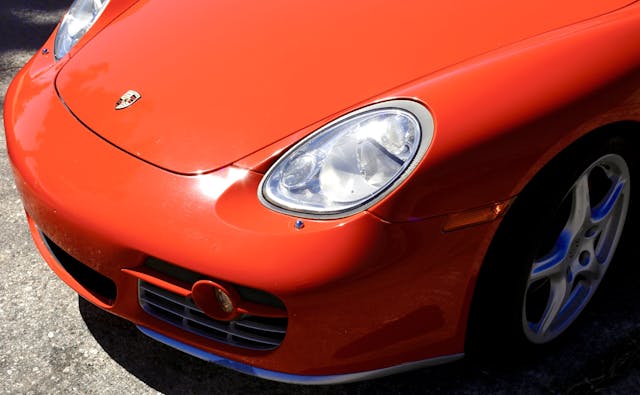 Peter Nelson
Peter Nelson
As far as easy reliability mods go, Navarro shares that Tiptronic-equipped Caymans came with a center transmission cooler situated between the two front radiators. Manual-equipped cars have the space to retrofit a third radiator setup, thus improving cooling substantially. Otherwise, going with a lower-temperature thermostat is an easy upgrade, as is replacing the shifter cables with higher-quality 911 GT3 units. For HPDE/track day driving, several companies offer deep oil sumps with baffles to increase oil capacity, which ensures adequate oiling at high cornering G.
When it comes to upgrades, the aftermarket is still teeming with options. The 987 Cayman is a brilliantly balanced sports car chassis that responds well to suspension, brake, and tire mods. Upgrading sway bars, end links, bushings, and control arms—particularly GT3-style units from a variety of reputable aftermarket suppliers—really magnify its strengths. Thankfully, its fenders accommodate substantially wider rubber than stock, too.
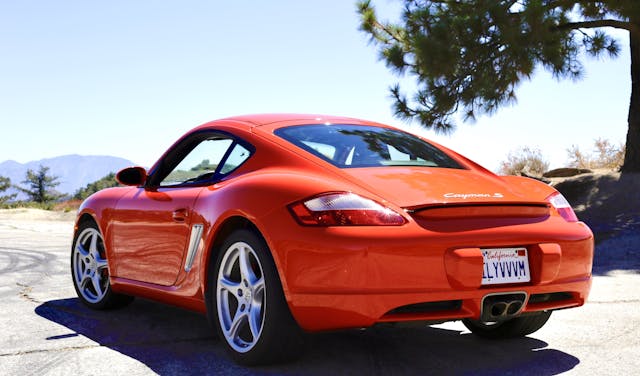 Peter Nelson
Peter Nelson
A Unique Sports Car Worth Experiencing
There’s a lot of appeal to the 987-generation Porsche Cayman. It’s tremendously fun to drive, surprisingly roomy and practical, nice to look at, a great city and highway car, and it offers a communicative mid-engine chassis driving experience at a reasonable price. The latter is somewhat rare, especially among European automakers—the only other real option sports a Lotus badge.
With the right care, it can be a rewarding car to own and a relatively easy entry into Porsche ownership without breaking the bank. And, given their age, badge, and desirable layout, these early Caymans are not likely to get any less valuable than they are now.

